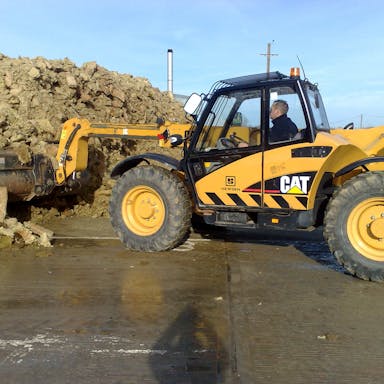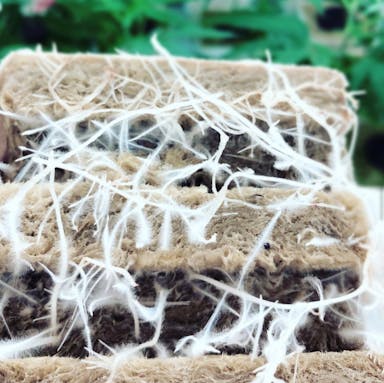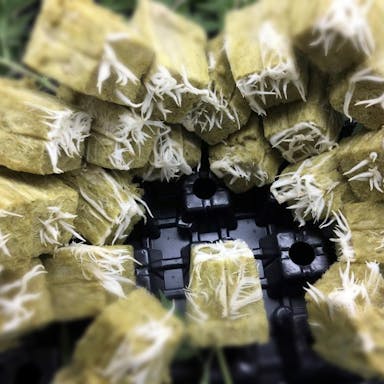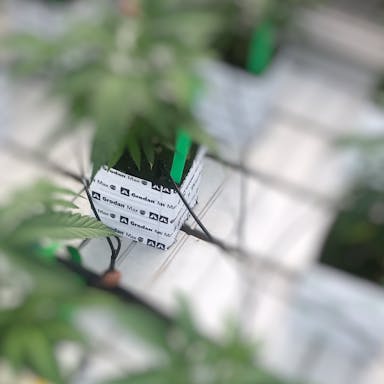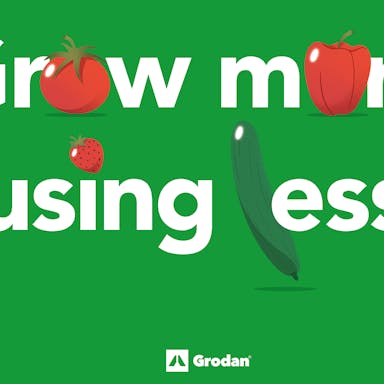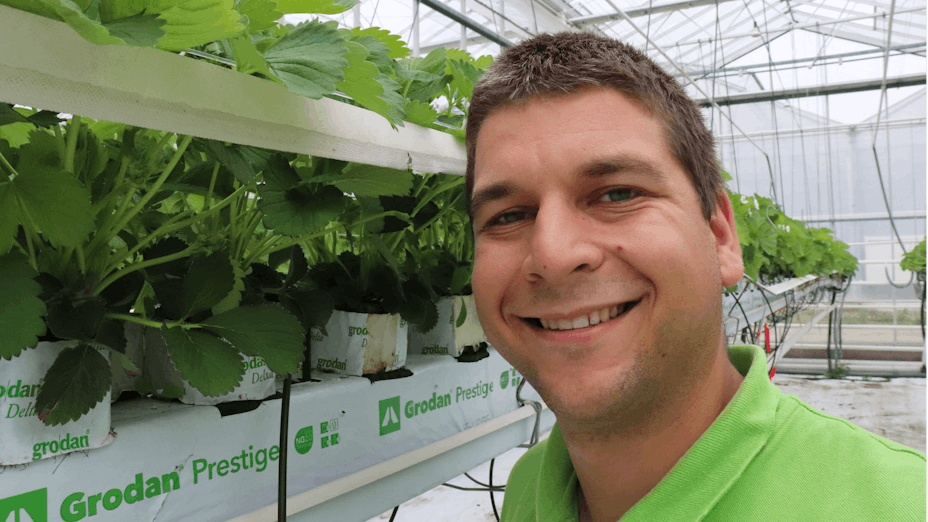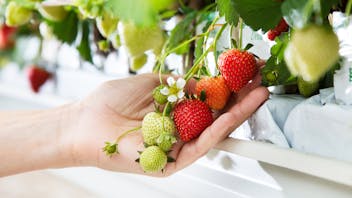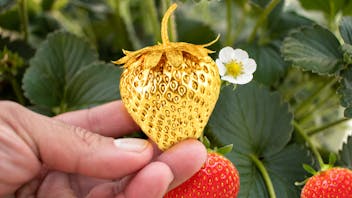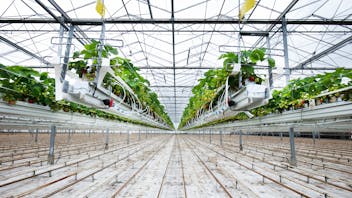What’s special about this experiment at Research Centre Hoogstraten?
“We’re trying to make responsible and innovative use of natural materials like substrate and mineral fertilizers. So we’re looking for new growing media and techniques to further improve strawberry cultivation. Most strawberry growers work with coco or peat substrate, which is very damaging to the environment from an ecological viewpoint. We also want to reuse the water needed for cultivation. But water that comes into contact with coco or peat becomes coffee-colored due to the high organic content, and is difficult to clean. Stone wool growing media could be a cleaner and more sustainable alternative.“
What makes growing strawberries on stone wool growing media so different?
“Strawberry growers usually work with coco or peat substrate and won’t easily switch to something different. That makes sense, as they first want to see positive results from stone wool growing media. Well, now we’ve got those results. And luckily, our manager has vast experience in growing peppers and tomatoes on stone wool, so I got a lot of support from him. He knows the precise differences between cocopeat and stone wool growing media with regard to irrigation and other nutritional needs. We also got a lot of help from the sensors from Grodan. These GroSens sensors gave detailed insight into what was going on in the stone wool substrates. The figures give you a good basis for steering cultivation.“
What made you think of using stone wool growing media from Grodan?
“At Research Centre Hoogstraten, we’re conducting research into three crops: peppers, tomatoes and strawberries. Our colleagues have been working with stone wool growing media solutions from companies such as Grodan in the cultivation of peppers and tomatoes for a long time already. When we enquired at the end of 2018 about the possibility of growing strawberries on stone wool growing media, our colleagues were immediately enthusiastic: ‘Do it!’ And so we did – for this experiment.“
Why do you use GroSens?
“Stone wool makes it possible to optimally steer the quantities of water and nutrients. Grodan’s sensor system, GroSens, gives you real-time insight into this data, so that you can be even more precise in taking decisions and steering. On a personal level, too, I think this data-driven work is really fantastic. It’s a useful tool for steering based on figures. Precision growing – yes!”

What’s the first step for growers who are planning to cultivate strawberries on stone wool growing media?
“To get the best out of growing on stone wool, it’s important to make use of its physical qualities, which allow you to steer the irrigation strategy and provision of nutrients separately. This is totally different to working with coco or peat substrate – so just give it a try. It’s also important to put the stone wool blocks in the system of trays, in order to combat the spread of disease. You get about nine or ten plants on these trays. At first, we didn’t have the trays and decided to work in the open air with overhead sprinklers, with the plants standing on plastic. That led to infections, so we lost some plants. With a simple adjustment the stone wool blocks now fit into the tray pots, so the plants aren’t in contact with the ground and there are no infections. I’d also recommend getting advice from someone who’s familiar with stone wool growing media, so you’ve got the right help to start off well.”

What can you tell us about the experiment at Research Centre Hoogstraten in cultivating strawberries on stone wool growing media?
“In the first experiment, we already observed that the strawberry production on stone wool growing media offered great prospects. The fruit was equivalent in size and weight to the fruit grown on traditional cocopeat substrate. On the tray field - between June 2019 and December 2019 – we didn’t yet manage to optimize the cultivation of strawberry plants. The plant roots were standing in water, making it easy for fungal diseases to spread. That was reflected in production, with a loss of 20 percent. Despite these loss figures, production turned out similar to that of traditional substrate. If we can improve the cultivation method in follow-up research by putting the stone wool in trays, for example, we’ll probably be able to drastically reduce the loss figures.”

What prospects for the future are shown by this experiment?
“Stone wool growing media can take strawberry cultivation in a new direction. It’s clear that it has huge potential for precision growing. We still need to look at the economic feasibility for classic strawberry cultivation during a six-week period in the summer. But if you look at the extended growing season from August to March, for everbearing or double cropping varieties, it can be very interesting economically. Technically speaking, it’s feasible, as long as those couple of adjustments are made. It’s also important that growers get the right training. As I said, it’s a very different way of working for most growers. Sensors like GroSens can be a good starting point to get familiar with stone wool as a growing medium.”
Read more about GroSens, the Grodan system that provides 24/7 real-time insight into the water content (WC), the EC and the temperature of the stone wool growing medium.
Research Centre Hoogstraten, a Grodan customer, collaborates with Coöperatie Hoogstraten, VITO Hoogstraten – Department Agriculture and Horticulture - in Meerle, Belgium, on expanding horticulture in the region. Research Centre Hoogstraten is active in research and information concerning the cultivation of strawberries (both indoors and outdoors) and the greenhouse cultivation of tomatoes and peppers.
This story is part of the Gro-Hacks series, in which we ask partners and friends of Grodan about the lessons we can learn from their innovative entrepreneurial stories.

Where the magic happens: unlock the potential of data driven decision making
Data science and AI technologies present us with so many opportunities to collect and mine data in the greenhouse. This paper will help you begin your journey to get the best out of your greenhouse data. There’s a bright future ahead!
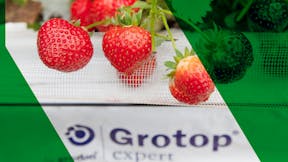
Food Forward: The promising future of strawberry cultivation
In this Food Forward, we discuss the possibilities and challenges of growing strawberries in the greenhouse with three experts from the sector. They give updates on the latest trends and developments in greenhouse strawberry cultivation, and share their predictions for future-proof, efficient strawberry cultivation.

Dowload the brochure about the 7 strenghts of stonewool
In our brochure we explain why stone wool is perfectly suited for growing healthy and fresh food efficiently and sustainably.
